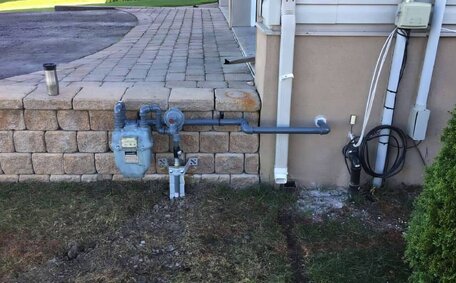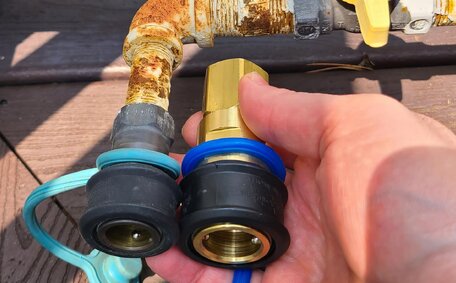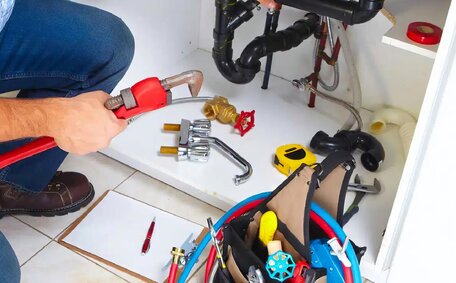Understanding Gas Regulators and How They Work
Pressure regulators play a vital role in controlling the flow of lpg gas from your propane tank to household appliances. What does a regulator do? Its essential role is to uphold a static gas pressure, remaining steady and consistent like a first stage regulator, before the gas is channelled into regulator mechanisms and your domicile’s gas lines and appliances.
Without a pressure regulator, without such control, gas coming through at extreme pressure from the common gas grill tank or main line could be perilous. This uncontrolled flow can cause gas leaks, damage to appliances, inconsistent flames, and even explosions or fires.
A typical gas regulator features an inlet valve receiving high-pressure gas, and an outlet side that curtails excess pressure, facilitating a controlled and steady flow into your appliances. Outlet pressures typically measure around 28 centimetres for RV propane and 18 centimetres for natural gas systems.
Single stage regulator and double stage regulator types are the most encountered variants in residential use, effective all way from first to last stage of pressure control, with meticulous control exerted after first stage regulation. Following the first stage, second stage regulator units provide added precision, ensuring the gas is properly moderated before it reaches your appliances. Your RV propane regulators, with automatic changeover capabilities, have an additional valve and gauge enabling more exact pressure propane control in RV applications and industrial environments.
Gas grill regulators often include a bypass valve to release excess pressure, enhancing safety. Some models feature a vent opening that can be rotated to prevent weather or debris interference.
While a gas regulator can generally endure a long time, typically replaced every five years to a decade, it’s critical to periodically inspect them for signs damage wear, as such degeneration can herald when the regulator fails, precipitating inconsistent gas flow. Professional replacement is suggested if you identify any issues during your evaluation that suggest it’s time to replace your propane regulator.
Common Signs of a Faulty Gas Regulator
There are several key indicators that your propane regulator may be failing and could require replacement:
Inconsistent or Abnormal Flame Heights
If you notice the flames on your burners of your gas appliances suddenly changing heights, flaring up and down without cause, this signifies the presence of an inconsistent flame due to a malfunctioning regulator.
Difficulty Igniting Appliances
If it’s become harder to light your gas oven, water heater, or your gas grill burners, this could be a sign that the regulator isnt working efficiently and may not be providing sufficient gas flow and pressure for ignition.
Unusual Sounds
Listen out for popping noises, hissing or whistling sounds that can be symptoms bad regulator or a problematic gas valve when in operation. This often signals disruptions in propane flow, indicative of high pressure as a symptom of regulator problems.
Gas Leaks
A gas leak at the connection point post-regulator, where a gas scent might be apparent, represents a sign faulty propane regulator and a significant safety concern. now turn off appliances without delay and reach out to a professional if fluctuations in inlet pressure or leaks are detected.
Any of the above require urgent regulator testing or replacement to restore proper gas control and prevent safety hazards or appliance damage.
Yellow or Weak Flames
Diminished flames, often producing low flame, are a clear sign pointing to a potential regulator fault.
Flames that exude yellow orange flames, displaying a lazy quality instead of the vigorous blue expected on a propane grill, suggest that the gas and oxygen are not blending correctly. This incomplete combustion produces carbon monoxide and black smoke rather than clean burning.
Causes behind yellow flames and weak combustion include:
- Low pressure gas from a failing regulator unable to supply adequate fuel
- Blocked burner ports above burner elements, whether on a stovetop or your grill, can highlight potential grill regulator problems
- An undersized regulator incorrectly matched to the BTU load
- Buildup of dirt, debris or rust inside the regulator
Addressing yellow flames promptly is vital to prevent gas leaks or explosions often associated with a faulty propane regulator. Begin troubleshooting by cleaning the appliance burners and conducting tests, as persistent issues may indicate a faulty regulator. If this is the case, you may need replace certain parts, therefore it’s wise to contact professional plumbing services to examine the regulator and gas piping system.
Replacing a faulty gas regulator often resolves yellow flame problems. Upgrading to a larger capacity unit may be needed to meet appliance demand and ensure strong blue flames.
Gas Odors
One of the most serious signs of a faulty gas regulator is detecting the smell of gas in your home. Natural gas and propane both release odours described as rotten eggs or sulphur when leaks are present. One of the most serious signs of a faulty gas regulator is detecting the smell of gas in your home.
Never disregard the smell of gas, whether or not appliances are in use. The gas could be leaking from your piping system due to excessive pressure passing through a faulty regulator. Left unchecked, this can lead to the accumulation of gas and create an explosion hazard if ignited.
If you detect the odour of gas, take the following steps:
- Immediately evacuate everyone from the building and move a safe distance away, ensuring all sources are turned off gas to prevent further hazards. Never operate switches or electronics that could cause sparks, especially if there’s too much gas in the air, and always turn off gas supply immediately in the event of a gas odour.
- Immediately call emergency services and describe the gas odour, relying on their expertise to safely manage the situation.
- If it’s achievable without risk, move the valve to the off position using the main gas supply control to your residence. For your propane system, manually shutting the tank’s valve is crucial to ensure its security and stability.
- Summon professionals to meticulously check for leaks in gas connections including your regulator, lines, and appliances for any stealthy issues. Repairs or a replace regulator action are likely needed before restoring service.
- Request documentation that your system was restored to code and safe operating functionality.
- Consider installing gas detectors as an extra precaution going forward.
A gas odour justifies the immediate shutdown of supply and inspection for potential regulator faults or leaks, so act promptly. Neglecting the smell may enable gas to permeate the gas line and reach explosive concentrations, risking major property damage or loss of life. Special care is required if small children or elderly residents are present.
Testing Your Gas Regulator
Testing your propane or natural gas regulator at least annually is crucial to identify potential faults before they become hazardous.
The following are key methods to evaluate if your regulator functionality is compromised:
Pressure Testing
Perform a pressure test with a gauge and compare the regulator’s outlet pressure against manufacturer specifications. Readings significantly deviating from the standard 18-28 centimetres suggest regulator issues.
Leak Testing
Use leak detector solution or soapy water on the regulator housing and connections to reveal faulty components. Bubbles signal gas leaks, suggesting regulator issues.
Flame and Flow Observation
Visually inspect burner flame quality and behaviour while turning appliances on and off. Inconsistent flames or interrupted flow gas points to insufficient fuel supply from the regulator.
Burner Port Inspection
Remove burner covers to check for debris blockages preventing proper gas combustion. If obstructions are absent, it’s a telling sign that the regulator bad needs adjustment or replacement.
Rectifying a faulty regulator often involves upgrading from older models to newer double-stage options that provide more accurate control over gas flow. Seek professional assistance if replacement or recalibration is required.
Replacing a Faulty Gas Regulator
Replacing a faulty gas regulator is crucial to restore proper gas pressure control and safe appliance operation. This task requires selecting the correct replacement regulator matched to your gas type and system capacity.
Here are the step-by-step instructions for replacing your regulator when propane has ceased flowing, signalling there no gas being supplied:
- Turn off the main gas supply valve located before the regulator inlet. For propane gas cylinder tanks, it’s crucial to manage the tank valve and turn it to the off position to guarantee safety.
- Use a pressure gauge to bleed off any remaining gas past the shutoff point.
- Disconnect old regulator gas piping connections using proper wrenches. Cap ends to contain leaks.
- Remove regulator mounting hardware and detach the unit.
- Compare new regulator type, inlet and outlet specifications to the old unit or system requirements.
- Attach replacement regulator with mounting hardware per manufacturer instructions.
- Reconnect gas piping to inlet and outlet with pipe compound to prevent leaks.
- Restore gas supply and use a pressure gauge to set regulator outlet pressure if adjustable.
- Leak test connections with soapy solution and check appliance burner flames for correct appearance.
Replacing gas regulators requires proper materials, precautions and procedures. Seek professional assistance if uncomfortable performing these steps.
When to Call a Professional
As a plumbing firm with a storied history, Marsfield Plumbing should be your immediate call should you detect any problem regulator concerns.
Check out our fully licenced and insured technicians who have the expertise to properly inspect, test, and replace faulty regulators on propane tanks and ensure your propane gas system is safe. We use advanced diagnostics to pinpoint regulator problems and restore safe functionality.
- Gas leaks or, on the other hand, unusual odours
- Visible regulator damage or corrosion
- Inconsistent gas appliance flames
- Difficulty igniting pilot lights
- Excessive yellow, weak, or abnormal flames
- Hissing or whistling from regulator/valves
Like any committed service, our technicians serve Sydney homes and businesses 24/7 in the event of gas emergencies. We also offer preventative maintenance plans and repairs to stop small regulator issues becoming dangerous situations.
For immediate help with faulty propane regulators or advice, dial 1300 349 338 to contact Marsfield Plumbing. Our approachable staff will arrange an inspection or discuss options for regulator upgrades.
Preventing Gas Regulator Issues
Following proper maintenance practises is key to preventing common regulator propane faults before they occur:
Annual Inspections
Have a licenced technician annually assess your regulator performance and integrity, they’ll advise when youll need new components. They can spot early signs of regulator issues and adjust your gas pressure, advising when new parts are necessary.
Visual Checks
You should always check exterior regulator components for physical damage, rust, debris accumulation and other visible issues. Address any abnormalities immediately to avoid operational failure.
Flame Observation
Periodically inspect burner flame characteristics for proper size, colour and combustion consistency. This reveals symptoms of a propane regulator bad impacting gas flow.
Ventilation
Ensure adequate ventilation around regulators to prevent moisture or dirt buildup leading to corrosion or blockages over time.
Safety Upgrades
Upgrading older single-stage regulators to dual-stage models improves flow capacities and precision in fuel control. Improper regulation underscores the need regulator upgrades to avoid undermining the performance your appliances deliver or creating hazardous conditions.
Marsfield Plumbing’s licenced technicians are experts in inspecting, troubleshooting, and replacing faulty gas regulators for Sydney properties. We provide customised preventative maintenance plans.
Proactive upgrades of regulators close to or beyond 10 years can improve both safety and reliability. Contact our friendly team on 1300 349 338 to discuss regulator lifespans or schedule an inspection.






